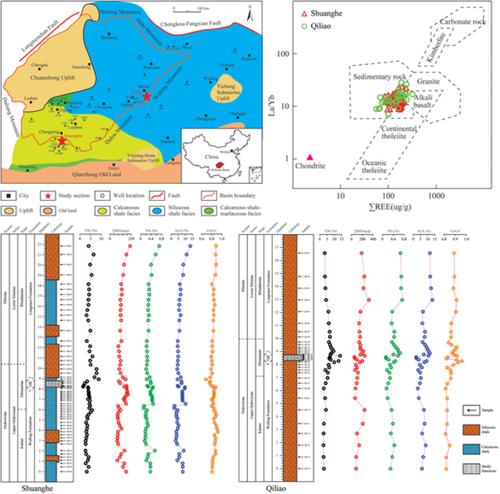当前位置:
X-MOL 学术
›
Geolog. J.
›
论文详情
Our official English website, www.x-mol.net, welcomes your
feedback! (Note: you will need to create a separate account there.)
Geological significance of rare earth elements in marine shale during the Late Ordovician–Early Silurian in Sichuan Basin, South China
Geological Journal ( IF 1.4 ) Pub Date : 2020-11-07 , DOI: 10.1002/gj.4027 Bin Lu 1 , Zhen Qiu 1 , Bao‐Hua Zhang 2 , Jian Li 1 , Hui‐Fei Tao 3
Geological Journal ( IF 1.4 ) Pub Date : 2020-11-07 , DOI: 10.1002/gj.4027 Bin Lu 1 , Zhen Qiu 1 , Bao‐Hua Zhang 2 , Jian Li 1 , Hui‐Fei Tao 3
Affiliation

|
Rare earth elements (REEs) record a large amount of geological information, and serve as a good geological indicator that can effectively predict the palaeoclimate, palaeoenvironment, and palaeotectonic evolution of the sedimentary rocks. The REEs and major elements of 94 marine shale samples obtained from the Late Ordovician to the Early Silurian at Shuanghe (SH) and Qiliao (QL) sections in Sichuan Basin were analysed in this study. Results showed that the major elements of Al2O3, K2O, and TiO2 were mainly controlled by clay minerals associated with terrigenous detrital, but the SiO2 and Na2O were not influenced by clay minerals. In addition, ΣREE values obtained at Shuanghe and Qiliao sections during the Late Ordovician–Early Silurian were close to those of North American Shale (NASC) composites (173.2 ug/g). REEs were characterized by light rare earth elements enrichment, but heavy rare earth elements depletion. Furthermore, the NASC‐normalized REE patterns were similar with a little difference at Shuanghe and Qiliao sections. The following conclusions were drawn by studying REE indicators associated with source, redox condition and the mechanism of organic matter enrichment: (a) ΣREE showed strong positive correlations with TiO2, Al2O3, K2O, and Na2O, but exhibited relatively poor correlations with Fe2O3 and P2O5. These results suggested that REEs in the marine shale mainly occurred in clay minerals, but also were influenced by pyrite, phosphates, and other minerals. (b) Ce/Ce* showed that marine shale during the Late Ordovician–Early Silurian was mainly deposited under anoxic condition in Sichuan Basin and the reduction intensity at Qiliao section was stronger than Shuanghe section. (c) The diagram between La/Yb and ΣREE and the Ce/Ce* values indicated that the detrital minerals in the marine shale were mainly derived from the sedimentary rocks and deposited in the same continental margin environment with a complex composition. (d) The controlling factors of organic matter enrichment were different at Shuanghe and Qiliao sections and the depositional environment controlled the organic matter accumulation and preservation of the organic‐rich marine shale.
中文翻译:

华南四川盆地晚奥陶世-志留纪早期海相页岩中稀土元素的地质意义
稀土元素(REEs)记录了大量的地质信息,并作为良好的地质指示剂,可以有效地预测沉积岩的古气候,古环境和古构造演化。本研究分析了四川盆地双河(SH)和奇ilia(QL)段奥陶纪晚期至志留纪早期的94个海相页岩样品的稀土元素和主要元素。结果表明,Al 2 O 3,K 2 O和TiO 2的主要元素主要由与陆源碎屑有关的粘土矿物控制,而SiO 2和Na 2O不受粘土矿物的影响。此外,在奥陶纪晚期-志留纪晚期的双河和奇ilia剖面获得的REE值与北美页岩(NASC)复合材料的值接近(173.2 ug / g)。稀土元素以轻稀土元素富集为特征,而重稀土元素贫化为特征。此外,NASC归一化的REE模式相似,在双河和七ilia剖面上有少许差异。通过研究与来源,氧化还原条件和有机质富集机理相关的REE指标得出以下结论:(a)ΣREE与TiO 2,Al 2 O 3,K 2 O和Na 2呈强正相关。O,但与Fe 2 O 3和P 2 O 5的相关性较差。这些结果表明,海洋页岩中的稀土元素主要发生在粘土矿物中,但也受到黄铁矿,磷酸盐和其他矿物的影响。(b)Ce / Ce *表明,晚奥陶世—志留纪早期的海相页岩主要是在缺氧条件下沉积在四川盆地,奇Q剖面的还原强度强于双河剖面。(c)La / Yb和ΣREE之间的关系图和Ce / Ce *值表明,海相页岩中的碎屑矿物主要来自沉积岩,并沉积在同一大陆边缘环境中,具有复杂的成分。(d)双河段和七ilia段有机质富集的控制因素不同,沉积环境控制着富含有机质海相页岩的有机质积累和保存。
更新日期:2020-11-07
中文翻译:

华南四川盆地晚奥陶世-志留纪早期海相页岩中稀土元素的地质意义
稀土元素(REEs)记录了大量的地质信息,并作为良好的地质指示剂,可以有效地预测沉积岩的古气候,古环境和古构造演化。本研究分析了四川盆地双河(SH)和奇ilia(QL)段奥陶纪晚期至志留纪早期的94个海相页岩样品的稀土元素和主要元素。结果表明,Al 2 O 3,K 2 O和TiO 2的主要元素主要由与陆源碎屑有关的粘土矿物控制,而SiO 2和Na 2O不受粘土矿物的影响。此外,在奥陶纪晚期-志留纪晚期的双河和奇ilia剖面获得的REE值与北美页岩(NASC)复合材料的值接近(173.2 ug / g)。稀土元素以轻稀土元素富集为特征,而重稀土元素贫化为特征。此外,NASC归一化的REE模式相似,在双河和七ilia剖面上有少许差异。通过研究与来源,氧化还原条件和有机质富集机理相关的REE指标得出以下结论:(a)ΣREE与TiO 2,Al 2 O 3,K 2 O和Na 2呈强正相关。O,但与Fe 2 O 3和P 2 O 5的相关性较差。这些结果表明,海洋页岩中的稀土元素主要发生在粘土矿物中,但也受到黄铁矿,磷酸盐和其他矿物的影响。(b)Ce / Ce *表明,晚奥陶世—志留纪早期的海相页岩主要是在缺氧条件下沉积在四川盆地,奇Q剖面的还原强度强于双河剖面。(c)La / Yb和ΣREE之间的关系图和Ce / Ce *值表明,海相页岩中的碎屑矿物主要来自沉积岩,并沉积在同一大陆边缘环境中,具有复杂的成分。(d)双河段和七ilia段有机质富集的控制因素不同,沉积环境控制着富含有机质海相页岩的有机质积累和保存。











































 京公网安备 11010802027423号
京公网安备 11010802027423号